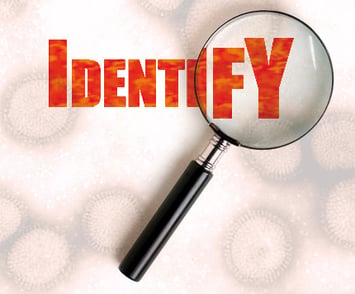 As I mentioned in my last post in this series this is the sales series, this is not necessarily the sales process that is going to work for every company; however, it is the one that I was taught, followed, and executed successfully for the past four years.
As I mentioned in my last post in this series this is the sales series, this is not necessarily the sales process that is going to work for every company; however, it is the one that I was taught, followed, and executed successfully for the past four years.
Now that we have an understanding on the context around why sales professionals need to change -- namely, that 60% of the buying process is done without them (but not necessarily BEFORE talking to a sales rep) -- I'll dig into what the first stage of the Inbound Sales Process looks like. This is referred to as the "IDENTIFY" (RESEARCH) stage in the four-stage process.
Ideally, research should be preceded by a complete understanding of your company’s Buyer Personas. If you’re not familiar with a buyer persona, this is a stereotype -- in the best sense of the word -- of what your ideal buyer or customer looks like.
A buyer persona is a full definition of:- The industry, or industries your prospects work in,
- Their common job title, or titles
- Their demographics -- where do they live, how many kids do they have, how much money do they make, etc
- Their core business objectives (Goals)
- Their core business challenges and what keeps them up and night
- In some instances, this can even include their personal life goals, especially if you’re selling into small businesses
Here’s a more detailed example from my colleague, Pamela Vaughn, and the rockstar marketing team at HubSpot:
READER'S NOTE --> "Use our free, downloadable persona template to organize the information you've gathered about your persona(s). Then share these slides with the rest of your company so everyone can benefit from the research you've done and develop an in-depth understanding of the person (or people) they're targeting every day at work. Here's how to use the template to do it ..."
Fill in Your Persona's Basic Demographic Information
If you didn't feel comfortable asking some of these demographic-based questions on the phone or in person, you can also conduct online surveys to gather this information. Some people are more comfortable disclosing things like this through a survey rather than verbal communication.
It's also helpful to include some descriptive buzzwords and mannerisms of your persona that you may have picked up on during your conversations to make it easier for people in your sales department to identify certain personas when they're talking to prospects.
Here's an example of how you might complete Section 1 in your template for one of your personas:
Share What You've Learned About Your Persona's Motivations
This is where you'll distill the information you learned from asking "Why" so much during those interviews. What keeps your persona up at night? Who do they want to be? Most importantly, tie that all together by telling people how your company can help them.
Help Your Sales Team Prepare for Conversations With Your Persona
Include some real quotes from your interviews that exemplify what your personas are concerned about, who they are, and what they want. Then create a list of the objections they might raise so your sales team is prepared to address those during their conversations with prospects.
Help Craft Messaging for Your Persona
Tell people how to talk about your products/services with your persona. This includes the nitty gritty vernacular you should use, as well as a more general elevator pitch that positions your solution in a way that resonates with your persona. This will help you ensure everyone in your company is speaking the same language when they're having conversations with leads and customers.
Finally, make sure you give your persona a name (like Finance Manager Margie, IT Ian, or Landscaper Larry), and include a real-life image of your persona so everyone can truly envision what he or she looks like.
Now What?
If you’ve gone this far, you already have a good grasp of the research phase. However, it doesn’t stop there. You still need to think about who specifically you are going to call.
If you’re fortunate enough to have a killer marketing team generating leads for you, and ideally passing you lead intelligence about how they’ve interacted with your marketing, here are some of the steps I went through as a rep.
What To Do Once You Have Target Leads to Call / Email/ Engage via Social/ In-Person
Have You Identified a Single or Many Contacts?
I would look to see if there have been multiple contacts from the company that engaged with my company, or just one. The more contacts the better because I always took the approach of working a company, NOT a lead or individual contact. As is outlined in Predictable Revenue, we know that the person we need to start the conversation with is often difficult to identify, and the person we typically need to speak with to make a purchasing decision is NOT the person we are going to start our sales discovery process with.
Recency and Frequency of Interaction?
When was the last time this person was on my company’s website. What did they look at? Was it a top of the funnel piece of content (blog post, ebook, webinar, etc)? Or was it a bottom of the funnel piece of content (free consultation request, demo request, pricing page view, started a free trial, etc)? Knowing this matters because it is going to give me a sense of how deep they are in their decision-making process. It will also help me understand how much self education they’ve done versus how much I may need to do. No amount is “bad”, I just don’t want to “oversell” or “undersell”. I have to find the “Goldilox” amount of information to prepare.
Is This a "Micro" Buyer Persona?
Your business may have a buyer persona, or buyer personas, developed, but there are probably mutiple sub-sets of buyers. For example, at HubSpot we have a few core buyer personas. Marketing Mary -- a marketing manager at a mid-sized org; Corporate Kathy -- a marketing manager or CMO at a slightly larger organization; Agency Erin -- a marketing agency owner looking to grow and scale her business; and the list goes on. For example, within Agency Erin, we have 5 key sub-personas. And those personas revolve around the slightly nuanced business challenges that different types of marketing services agencies might face. For example, a website development firm is likely to struggle with cash flow issues, while an SEO/ PPC/ Social agency is probably struggling to grow the size of their retainers and prove ROI. Because their challenges differ, I’m going to position my conversation differently. I need to tailor that conversation and add value by demonstrating my knowledge of their business in order to gain their trust.
General Demographics?
And of course, I want to understand some basic information about the types of businesses my prospect sells to, whether or not they are B2B or B2C, average sales price of a service or product beforehand if I can figure that out, how many employees work at the business, how long the business has been around for (especially for small business), whether or not the company -- OR PERSON -- was mentioned in the news (positively or negatively) or won any awards, and I want to soak in as much information through their LinkedIn profile as possible. I might even look through the company’s blog if they have one, or the company’s or prospect’s Twitter handle to see what they care about, who they interact with, and what types of information they’re sharing.
A Final Thought on Time Management During the IDENTIFY Stage of the Inbound Sales Process
This entire research and identification process -- once you get your method down -- should not take more than 3 to 5 minutes. Of course, if you’re working large enterprise deals, you’re going to want to spend a good deal more time mapping out the account and opportunities that exist within it. Delegate as much as you can to your BDR/ SDR, but coach them along the way on what types of information they should be looking for, especially if you’re working in a named accounts model. If you’re working a larger territory or prospect universe, you’re going to need to keep your activity high, so 3 to 5 minutes is enough. Early on, this could take you 10-20 minutes per prospective company; but as you progress the time required will diminish.
And if you’re wondering how to approach a COLD lead, the answer is that it’s mostly the same. The key difference is in how you open the conversation. As opposed to leading with how that person was interacting with your company recently, you’ll likely need to explain why you researched and decided to call that person specifically; and of course, how you typically help people like them. Be helpful, add value. Doors will open over time.
In the next post, I'll talk about how to actually go about calling, leaving voicemails, sending emails, reaching out via Social, etc -- the "CONNECT" Stage of the Inbound Sales Process.





